What and how to feed little rabbits
The profitability of any farm depends largely on the amount of produce to sell. Rabbit breeders often ask themselves: how to feed little rabbits so that they gain weight faster?
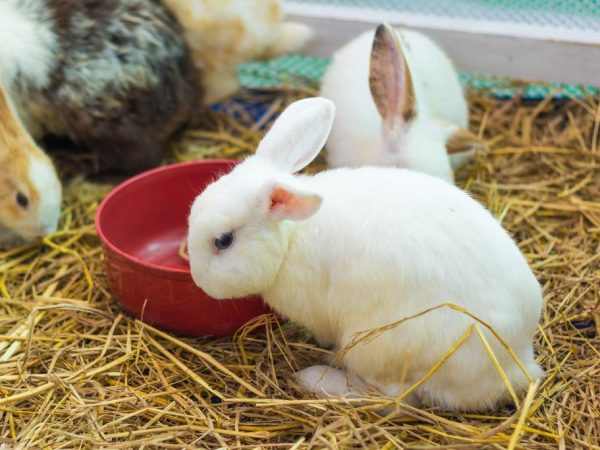
How to feed little rabbits
Conditionally, the life of the cubs after birth can be divided into two periods: feeding by the mother and the transition to dry food. Correct feeding of the rabbits is the key to healthy animals and the breeder's profit. However, sometimes the female refuses the cubs. In this case, the question of how to feed the little rabbits is especially acute. Some farmers argue that it is possible to feed refuseniks with fresh cow milk, others that with goat. Both options have their pros and cons.
Maternal feeding
The rabbit's pregnancy lasts approximately 30 days. During this time, the female should be fed a large amount of concentrates so that she has the strength to carry the cubs and feed them after. In one litter, from 4 to 8 small fluffs are born. The more cubs there are in one litter, the sooner the offspring comes.
Newborn pussies are born completely defenseless, blind and naked. Up to two months, such babies are fed by a rabbit. The entire diet of the young is made by the mother's nutritious milk. If the babies are pulled away from the female too early, then they may have problems with the digestive system.
Most often, early weaning of offspring is practiced on large farms with a tight fertility schedule. The female is mated on the second day after giving birth, and she feeds the cubs when she is pregnant. If the babies are not removed in time, then the rabbit will not be able to bear and give birth to new healthy offspring.
Babies can try their first green food at 2 weeks of age. Until that time, they feed exclusively on mother's milk.
Sometimes it happens that the rabbit's maternal instinct disappears and she refuses to feed the cubs. Most often this is due to the inexperience of the female. Breeding breeds of rabbits are also susceptible to similar behavior.
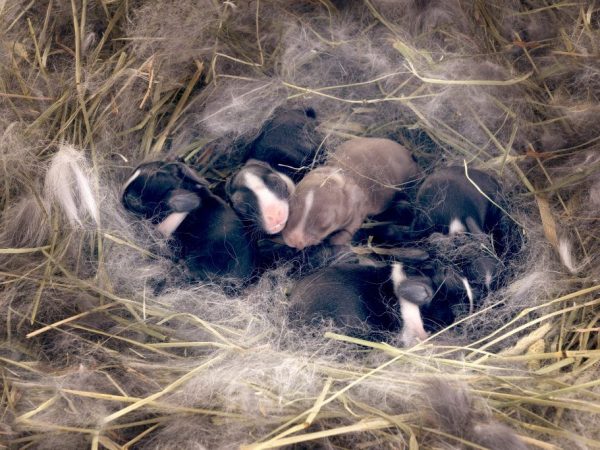
Feeding newborn rabbits
If the problem is not solved within a week, newborn babies may die. The rabbit can be held in a sitting position over the nest 2-3 times a day. This is done if there are no more nursing females on the farm, or if everyone has given up their babies. In this position, the cubs are able to find the mother's breast on their own and begin to suckle milk.
There is the following scheme for how to feed rabbits:
- Newborn cubs feed on rabbit milk for 2-3 weeks.
- At the age of 3-4 weeks, they still drink milk, but they can already consume dry food and fresh hay in small quantities.
- Juveniles aged 1-2 months feed on lactose with a gradual increase in dry food and greens.
With the help of this schedule, you can feed healthy offspring, which by 6 months will already be able to have an active sex life. Rabbits have a high birth rate, which ensured their survival in the wild.
For babies to develop strong and healthy, the mother's food must be balanced and contain the whole range of nutrients. It is important to monitor both the quality of feed and their food value.
Rabbit diet during lactation
It is a mistake to believe that only pregnancy is a great burden on the body. First, the lactation period also requires a lot of energy. Secondly, very often at the time of feeding, the female is again on the drift. As a result, the rabbit requires a large amount of high-calorie and vitamin-rich feed.
The female produces up to 200 g of milk for the cubs at knocks. This amount must be replenished with protein, otherwise the animal will become depleted.
Compared to the usual period of life, a nursing rabbit requires 2-3 times more food. You should change the diet every 2 weeks during feeding:
- 1-10 days: 330 g feed units;
- 11-20 days: 430 g;
- 21-30 days: 570 g;
- from day 31 to weaning: 670 g.
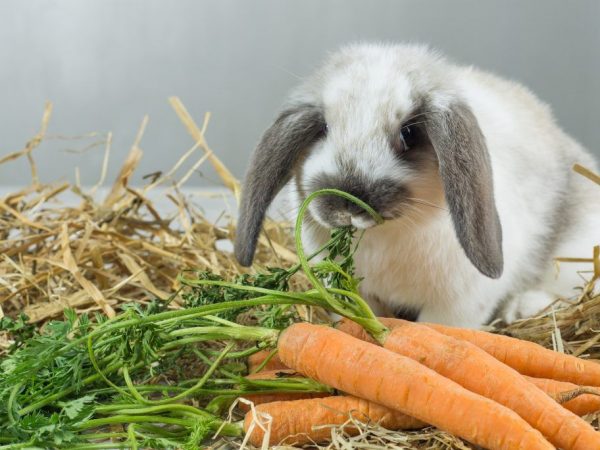
Feeding during lactation
During the feeding period, the rabbit needs a lot of protein and calories, so juicy feeds are best suited for this task. In winter, legumes, root crops, potatoes, and silage are suitable for this. In summer, it is permissible to use clover, bran, oat mixtures and herbs in the diet. Concentrated feed should be fed with oats, bran, wheat, corn and peas. During the feeding period, concentrates should make up at least 80% of the daily diet.
In addition, a rabbit's day requires 200 g of hay, several grams of fish oil and feed yeast. It is also imperative to feed the animal with bone meal, chalk and salt.
If there are no minerals in the rabbit's feed, then their lack will affect the quantity and quality of milk. To increase lactation, experienced farmers advise dried milk fodder. Dill, parsley or nine-force will cope with this task.
Also, a nursing rabbit should be given various mixtures of oats, hay and mineral components. You can mix oats with barley, but the latter should be peeled off before feeding.
Feeding rabbits without a female
Sometimes the female refuses to feed her offspring because of the missing maternal instinct or for health reasons. It is sometimes difficult to know the true cause of this behavior, but the signs are hard to overlook. The rabbit begins to scatter the kids around the cage and behave aggressively with them. How to feed a rabbit for up to a month? If such a nuisance happened to the newborns, then the babies who did not get their mother's milk will have to be transferred to artificial nutrition. Since the body of newborn fluffies up to one week of age does not differ in strength, this must be done correctly. A similar procedure can be done at home.
There is an opinion among farmers that artificial feeding is better with goat milk (but fresh cow milk is also drunk. Goat milk is simply more nutritious, its fat content is higher and it contains more nutrients. If there is no access to fresh goat milk, then you can buy puppy feeding mixtures from your veterinary pharmacy.
Milk for feeding is poured into a plate and slightly warmed to natural temperature. You need to hold a small rabbit in your hand and feed it drop by drop with milk from a pipette. At each feeding, it is permissible to give at least 10 drops. All equipment must be disinfected before use, otherwise the cub may get sick. Those who do not know how to feed babies with a pipette at home can watch educational videos.
Feeding babies with cow's milk should be frequent and small. Newborn rabbits up to a week old should eat 5 times a day. In the first few days, the cubs need help to empty themselves, because in natural conditions, the rabbit provides help.
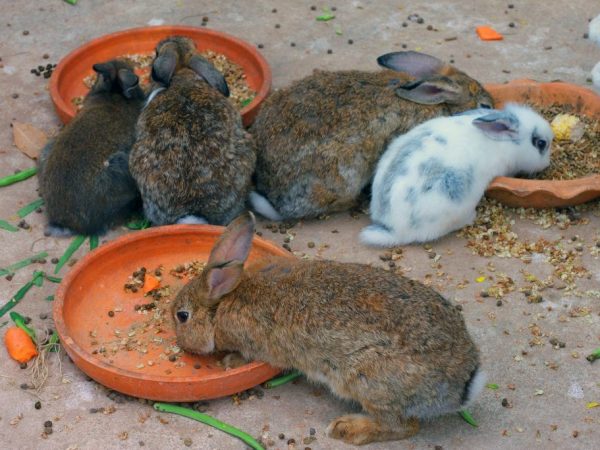
Feeding young rabbits
In order for the rabbits to go to the toilet, their bellies are rubbed with damp cotton swabs.In its consistency, it should resemble the wet nose of a female. It is required to massage the abdomen of the rabbit until it is empty. Such actions must be performed daily for 15 days. After the stomachs of babies begin to grow stronger, and they can go to the toilet on their own.
In the first few days, newborn babies need a lot of light, but after 2 weeks, it is better to highlight a dark corner in the corner of the mother liquor. Two-week-old bunnies are eye-opening and love to sleep in dark, secluded places.
If artificial feeding is successful, then by the 3rd week of life the rabbits already begin to lap milk from the saucer. It is important to remember that rabbits are very active animals. They can crawl into the open drinker with their front paws or throw debris. By the end of the first month of life, babies can already be given carrots, green hay or grass. Take care of the presence of green grass in winter. To do this, you can grow it specifically for okrol at home. Rabbits who have not received the female's milk are advised to give hay and grass flour. Gradually it is necessary to introduce wet mixtures of concentrates into complementary foods. You can cook porridge.
Youngsters should not be given cabbage leaves, even if they eat them well. The digestive system of animals is not yet fully formed, therefore, diarrhea may begin in rabbits. This is often fatal.
It is necessary to observe sanitary standards when feeding. Everything that you give to babies should be fresh, without mold or sourness. Greens and vegetables must be washed, and the mixture must be prepared before feeding.
How to feed young animals after jigging
Baby rabbits are removed from their mother when they reach the age of one month. Sometimes this period can be extended up to 1.5 months. This time difference depends on how much the rabbits weigh at the time of jigging. The first week after weaning is the most important, you need to closely monitor the babies and their behavior. If suddenly the cubs began to die, then the cause of death of the monthly rabbits was most likely an incorrectly composed diet.
The gastrointestinal tract of the separated rabbits is not yet fully formed, and the immunity has not really developed. During this period of life, rabbits are especially vulnerable to various intestinal infections. To avoid these problems, it is important to remember that the food must be easy to digest and high in calories.
As food, young animals can be given legume-cereal hay, young grass, boiled potatoes and bran. Concentrates should be crushed or refined, depending on the cereal content of the feed. In small quantities, bone meal, fish oil and chalk are introduced into complementary foods. In the first months of life, rabbits need these components for the growth and development of bone tissue.
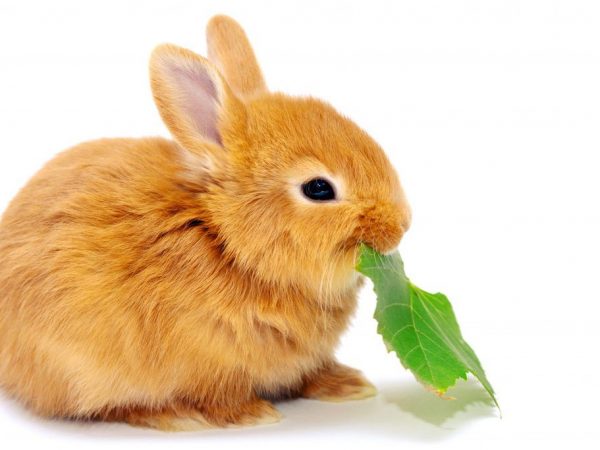
For rabbits, bean-cereal hay, young grass, boiled potatoes and bran are perfect.
At the time of jigging, one-month-old cubs should be fed with the same food as the mother during lactation. New types of feed are mixed gradually, otherwise the stomach of young animals may not be able to withstand. To make the animals feel more calm, a little vitamin B can be added to the drinker. Sour milk or cottage cheese works well on the gastrointestinal tract of rabbits. Youngsters are forbidden to give chamomile, St. John's wort or yarrow. These plants can flush out the weak microflora of the stomach.
The critical period in rabbits lasts about a week. If the babies have adapted well to the new feeding conditions, then in the future they can already be fed with almost everything the same as adults. At the end of the second month, they eat up to 100 g of feed units per day, the third - about 150 g. By the fourth month, the daily rate of young animals can exceed 200 g of feed.
For every 100 feed units, rabbits need 17 g of protein. The first 5 months of life are considered the period of active growth in young animals. To find out exactly how to feed the rabbits, you should use the daily feeding tables.
In summer, the diet of young animals should look like this:
- grass and greens - 40%;
- concentrated feed - 60%;
- vitamins and mineral supplements in the amount of the daily requirement;
- in winter, the diet may undergo some changes due to the lack of greenery;
- hay of the highest quality - 10%;
- succulent feed and silage - 30%;
- concentrated feed - 60%;
- vitamins and mineral supplements in the amount of the daily requirement.
Young rabbits should have food constantly. The digestive system will not be able to work in a young rabbit if it does not eat well. Hay must be in the pet's diet in unlimited quantities. Hunger or thirst can seriously damage your baby.
It is forbidden to feed rabbits with baked goods or pasta. At 3 months of age, they can be given a little yeast to increase the calorie content of the meal.
The goal of breeders and farmers is healthy and robust offspring, which ensures a profit on the farm. To gain weight and quality of skins, rabbits should be properly fed and well cared for from the first days of life. So that all babies can live up to 6 months of age, those to whom the female did not give milk are transferred to artificial nutrition.


